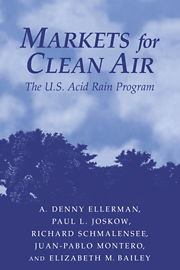Appendix: Effect of Title IV on SO2 Emissions and Heat Input by Susanne M. Schennach
Published online by Cambridge University Press: 10 December 2009
Summary
INTRODUCTION
This appendix presents the econometric analysis of the effect of Title IV on emissions and heat input, on which much of the discussion in Chapter 5 is based. Panel data regression techniques are applied to a large data sample, including more than Phase I units alone and more years than 1995–97, to account for the most important factors determining SO2 emissions. Three factors are particularly important.
Title IV can be expected to reduce SO2 emissions through a reduction in the emission rate as well as through a change in dispatch among units. Some of the effect may have taken place even prior to 1995.
The greater availability of low-sulfur PRB coals throughout 1995, 1996, and 1997, due to further reductions in rail rates or contract expirations, has to be considered.
Changes in electricity demand are a natural cause of fluctuations in heat input and emissions.
The model presented here is not intended to be a structural model of the electricity-generating sector to be used for testing the effect of a variety of economic and regulatory factors, as well as for forecasting. Rather, the model is tuned to answer a specific question, namely, the amount of SO2 abatement that can be attributed to Title IV.
This appendix is organized as follows. The next sections describe the database; introduce the econometric model and describe its features; present the results; address the effect of Title IV on utilization; and draw conclusions.
- Type
- Chapter
- Information
- Markets for Clean AirThe U.S. Acid Rain Program, pp. 323 - 342Publisher: Cambridge University PressPrint publication year: 2000



